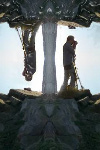
K-T Boundary: Diversity: An End
Algorri, Zumaia-Zumaya, Basque Country, Spain
March18, 2009, 16.34 hs local time
© 2009 Iñaki Rezola, All Rights Reserved.
Some 65 million years ago a huge meteorite hit our planet. As a result, the Earth's atmosphere was covered with dust and ashes for months, preventing the Sun's light from reaching the surface. This led to a massive species extinction (including the highly popular dinosaurs), reducing dramatically the diversity of existing lifeforms. What was finally left as evidence is a curious thin stone layer extremely rich in iridium – which is quite a rare metal on planet Earth, but not that much in meteorites.
This is called the K-T boundary, that sets apart the Cretaceous and the Tertiary. It may be found in the Zumaia-Zumaya coastline stretch shown in the panorama. Fossil evidence shows that under it, life used to thrive. Above it, most of the previous fauna and flora can't be found anymore. An end for diversity...
Or was it rather a fresh new starting point...?
(Charles Darwin was born 200 years ago on February the 12th, 1809, and published "The Origin of Species" 150 years ago. I'd like this to be a humble tribute to his work).
Français
Voilà qu'il y a quelques 65 millions d'années un grand méteorite heurta la terre de plein fouet. L'atmosphere en regorgea de cendres et poussière, sans que les rayons du soleil ne pussent atteindre la surface. Ceci provoqua une extinction massive de espèces (dont les dinosaures, tellement populaires de nos jours), et réduit considerablement la diversité de la vie sur notre planète. Le cataclysme laissa en guise de signature une toute petite couche de pierre extrêmement riche en iridium, métal plutôt exceptionnel sur notre Terre.
Cette couche est connue sous le nom de limite K-T, car elle sépare le Crétacique du Tertiaire. On peut la réperer à Zumaia-Zumaya. En dessous de cette couche la quantité et variété des fossiles témoignent d'une vie exhubérante. En dessus, la plupart des espèces auparavant abondantes sont désormais disparues. La fin de la diversité...
Ou ne serait-ce plutôt q'un tout nouveau début...?
(Charles Darwin est né un 12 février, il y a justement 200 ans, et 'L'Origine des Espèces' vut la lumière il y en a 150. J'aimerais que ceci soit un humble hommage à son grand oeuvre).
Esa capa es conocida como 'límite K/T' y separa el cretácico de la era terciaria. Bajo ella, el registro fósil testifica una variedad exhuberante. Sobre ella, la mayoría de las especies previamente existentes ha desaparecido. El final de la diversidad...
¿O tal vez un comienzo nuevo?
(Charles Darwin nació el 12 de febrero hace 200 años y su obra 'El origen de las especies' se publicó hace 150. Con este panorama quería rendir un pequeño homenaje a su gran obra).
KT mugaz ezaguna da geruza hori, Kretazikoa eta Tertziarioa banatzen dituela, eta Zumaiako kostaldean dugu ikusgai. Horren azpian fosilen ugaritusanak bizitzaren aberastasuna lekukotzen du. Goian, gehientxuak betirako desagertu egin dira. Aniztasunaren akabantza...
Ala abiapuntu berri bat ote...?
(Charles Darwin duela 200 urte otsailak 12an jaio zen, eta bere 'Espezieen Jatorriaz' duela 150 urte argitaratu zen. Panorama hau bere lan izugarriari omenaldi umil gisa eskaini nahi nioke).


 Tap or click the zoom icon in the bottom right corner of the picture to switch between in-page and fullscreen view
Tap or click the zoom icon in the bottom right corner of the picture to switch between in-page and fullscreen view